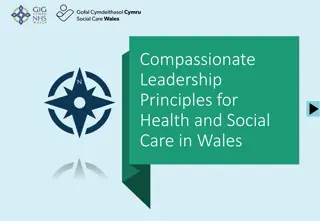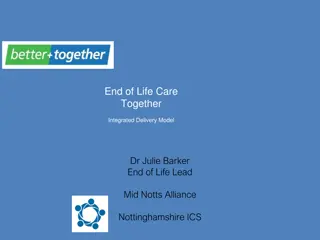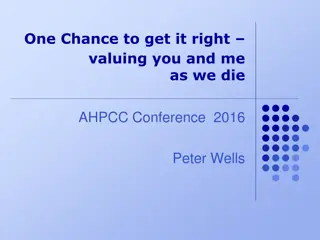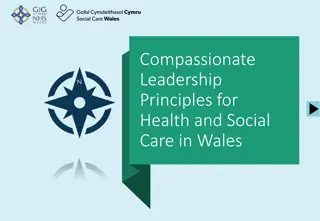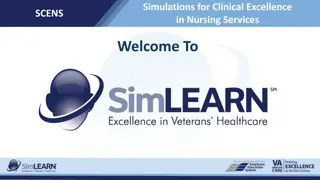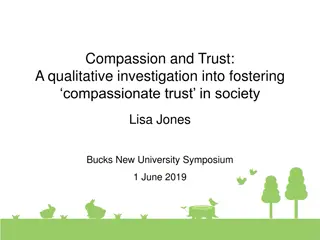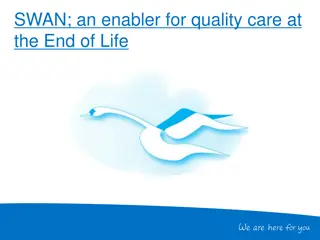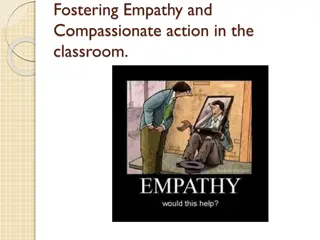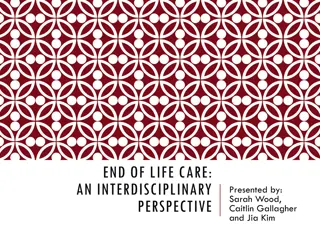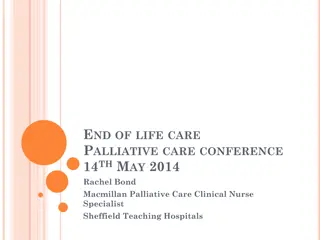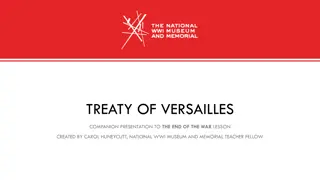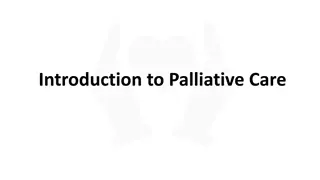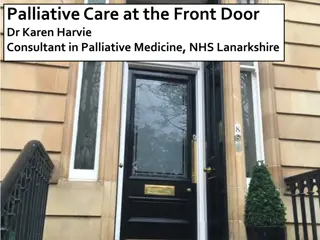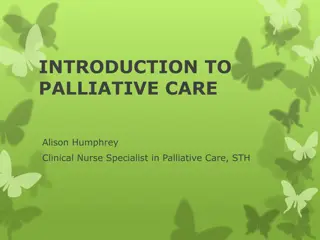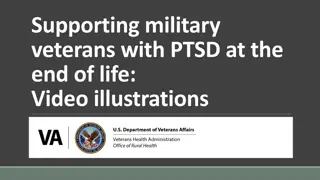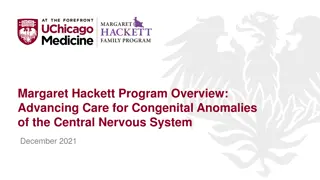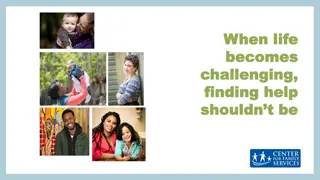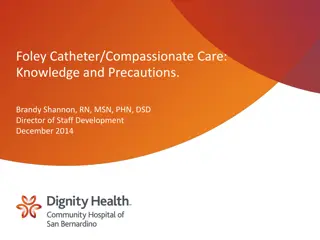Exploring Compassionate Companion Role in End-of-Life Care
Delve into the meaningful work of Compassionate Companions in providing support to individuals at the end of life. Reflect on creating healing environments, personal obstacles in volunteering, and maintaining boundaries in the role. Experience the essence of being a healing presence, support system, and reflective influence in a vulnerable setting.
- End-of-Life Care
- Compassionate Companions
- Healing Environments
- Volunteer Reflections
- Professional Boundaries
Download Presentation

Please find below an Image/Link to download the presentation.
The content on the website is provided AS IS for your information and personal use only. It may not be sold, licensed, or shared on other websites without obtaining consent from the author. Download presentation by click this link. If you encounter any issues during the download, it is possible that the publisher has removed the file from their server.
E N D
Presentation Transcript
Focus and Philosophy No One Dies Alone aims to provide compassionate companionship to those at the end of life who are isolated and may not have friends and/or family available. Our organization is dedicated to providing an atmosphere of support, sharing, self-reflection, and accepting vulnerability. Before making the commitment to volunteer, please consider your ability to mentally, emotionally, and physically, approach and be present during death and dying.
Exercise #1 Creating a Healing Space Look and feel the room around you. Assess the emotion, the lighting, the sound. How could you modify the room to be calmer? How could you modify the room to be a more healing environment? How could you apply similar elements to a patient s room? What do you anticipate being distractors? What could you modify to change them?
Original NODA Story Please read the NODA Origin Story attached to this packet.
Reflection #1 NODA Origin Story Why volunteer? What about the NODA story speaks to you? What personal obstacles do you anticipate facing? What obstacles do you anticipate we will face as a program?
Compassionate Companion What we are: A healing presence A support system A reflective influence What we aren t: Religious advisors A source of fixed answers or advice Clinical or professional personnel It can be difficult to separate your clinical and professional responsibilities from your volunteering. You may feel constantly called to fulfill your normal role and this role conflict can cause distress. It is important that you acknowledge this and keep your focus on your role as a volunteer. We ask that you please refrain from discussing or speculating on any clinical or medical information. If questions occur, please notify the nurse so she can direct the questions to the proper members of the team.
Reflection #2 Meaning of Compassionate Companion What are some other examples of what a compassionate companion should and should not be? How can you facilitate these roles and prevent yourself from being pulled into an inappropriate role? Consider how your professional role may cause confusion or difficulty for yourself or others when caring for a patient.
Exercise #2 Role of Compassionate Companion Consider the name of the program - No One Dies Alone What assumptions are being made? What if a person wants to be alone? What if you do not want to interfere with someone s sacred passage from life? What does this suggest about the role of the compassionate companion? What does the natural letting go aspect of death suggest about the role? What sensitivities to the dying process must we demonstrate? What does being alone mean to you? What aspect of being alone are we concerned with? What aspects of loneliness are we concerned about? Physically alone, emotionally alone, spiritually alone? Which aspect of loneliness would be most upsetting to you?
Reflection #3 Relationship with Death Think of a loved one you have lost. Was it anticipated? If so, what was done to prepare the person and family? What was the view and attitude of those involved? How did their passing affect you? How was the death spoken about or approached after? What does it tell you about your attitude towards death and dying? How does this affect your comfort level with death and dying? What will make you uncomfortable? What will increase your comfort?
Spiritual Care Aims to help with spirituality, peace and acceptance. Helps acknowledge questions like: Why am I here? Why is this happening to me? What can we do to bring a patient peace at end of life? Aids in discussing values, social supports, coping mechanisms. Volunteers are NOT expected to be spiritual caregivers. Spiritual care chaplains are available for support. Chaplains can assist volunteers to be spiritual companions if volunteer is comfortable. Goal is to help foster feelings of curiosity, relief, feeling grateful, and peaceful acceptance.
Palliative Care Care dedicated to comfort, pain relief, reducing suffering, and managing stress at end of life. Often involved prior to and especially when patient at end of life. Patients transition to comfort care when recognized to be at end of life. Patients who are responsive are usually aware that they are dying. Some situations prevent the patient from being able to grasp concept of death (intellectual disability, dementia, delirium). Palliative team can help navigate these situations if volunteer is uncomfortable.
Curing vs Healing Curing relates to the physical body. Healing relates to mind, body, spirit, hope, belonging, acceptance and peace. Cure may be out of reach, but there is always opportunity for healing. Healing is a process and a quality, not an event or outcome.
Being a healing presence Being with vs. doing to: Consider calming, voice, presence, and words. The simplest things are often what help most. A gentle touch, comforting words, a quiet presence. Addressing your discomfort. Being at the bedside at end of life can be uncomfortable. A desire to help can easily get mixed up in discomfort.
Using Voice, Sound, and Touch to Heal Calming, quiet tones can help set a mood of relaxation. Approach the vigil with a loving, kind, supportive and respectful intention. Talk to the patient whether they are responsive or not. Tell them who you are and that they are not alone. Tell them that you will be present with them for the next few hours. Reassure them that they are being taken care of and are in a safe place. Take the patients hand. There is power in touch especially when coupled with silence.
Exercise #3 A Healing Presence When you think about a healing presence what comes to mind? Have you received healing before in some capacity? How can you maintain that presence? Being in the moment and present with the patient. How can you prevent and address anxiety? The patient's needs are the focus. How can this focus be at odds with our own needs and feelings?
Discomfort/Debriefing Learning to sit with discomfort. Prepare yourself to be uncomfortable. Know that you may be sitting in a room alone with someone who is unresponsive. This person may be making noises (breathing, gurgling) that make you uncomfortable. There may be unpleasant/strong smells. The curiosity to see a patient pass may cause some new and unwanted feelings. You may feel guilt for having or focusing on these feelings. Being uncomfortable in this situation is OKAY. Many volunteers struggle to find comfort and purpose when present for a vigil, especially the first few. It is important to recognize when a patient is actually uncomfortable, or if their actions are making you uncomfortable. It is important to debrief after a vigil especially if the patient passes while you are on duty. Amanda and the team leads are here to talk with you and discuss your experience.
Personal Experience with Discomfort Steven Davidson I want to share some of my thoughts and feelings from my first vigil experience. The patient was only intermittently responsive. I was fine for the first 30ish minutes. Talking with them about music and helping to calm them with some of their favorite songs. As they became increasingly unresponsive, I found my mind beginning to wander. I felt the need to be distracted. I needed a phone or the internet, or someone to chat with. After about an hour, I began to think about the patient and their status. I became hyper focused on their breathing and actions and began to have a morbid curiosity about the patient passing while I was in the room, almost wanting it to happen. I was shocked and frustrated with myself for having that thought. I had a lot of guilt feeling like I wanted a patient to pass. I debriefed with my fellow team leads and found that they had similar experiences when sitting with this patient. The experience helped me cope and recover from my guilty feelings.
Compassion and Self Care It is very important to maintain good self-care when dealing with the emotional toll of sitting with a dying patient. Debriefing often is a useful tool as others will have shared experiences and can relate. If a patient passes on your shift, a debrief with the team leads is mandatory. Other self care activities (meditation, exercise, sleep, healthy eating) is important to maintain and we would like you to have an arsenal to use following your volunteer activities.
Exercise #4 Self-Care Please think of 3-5 self-care practices that have worked for you in the past. What will you do to ensure that you stay emotionally and mentally healthy during your time volunteering?
Death and Dying What it looks like Imminent days to hours before death. Trying to get out of bed or leave Labored breathing Apneic periods Cheyne-Stokes (A cycle of rapid breathing interrupted by periods of no breathing) Gurgling sound with breaths (normal unless accompanied by grimace) Cool extremities Pale, waxy, bluish skin Rambling speech Outwardly unresponsive Processing days to weeks before death. Sensitivity to light Confusion about time and place Dry/Cracked lips Hearing and smell are the last senses to fade. Talking and soft music are ways to let the patient know you are present, and they are not alone
Death and Dying What it looks like When Death Occurs: Heartbeat and breathing cease Pupils become fixed Urinary tract and bowels may release It is important to remember that death is the work of the dying, it is not your work. You are asked to stand witness and to reassure the dying one that they are safe a cared for.
Death and Dying Timing People pass when they are ready. Some can hold on until they have seen a final family member. Others want to pass privately. Passing privately and passing alone are different. Having companionship at end of life can give someone the closure they need to pass when they are ready. This can often occur when the nurses or volunteers have left the room for a short break giving the patient the time they need to pass in peace. This is not a reflection of or failure on the part of the volunteer. It is a natural phenomenon and should be respected as what the patient needed.
Death and Dying Protocol If you suspect a patient has passed while you are present (signs listed in previous slides). Alert nurse that patient may have passed via red call button please remain calm. Nursing will perform an assessment. Physician will be consulted and determines death of patient. Physician will verbalize death to those present in the room. Nurses prepare body for transport 4-hour window for body to be removed. Spiritual care and social work flagged after passing. The volunteer is not required to stay during this time but may wish to do so. Be prepared for all expressions of grief anger, sorrow, solemnity, indifference, denial, acceptance, solemn joy/relief. Volunteer will contact team leads when a patient passes during their shift. You will be required to schedule a 1-on-1 debrief with a team leader. Understand that patients may pass while you are taking a break or during short period between shifts This is a natural phenomenon and volunteer should not feel any guilt. The patient passed when they needed to. If you arrive and the patient passed between shifts please let the team leaders know so vigil can end.
Shift Restrictions You will be asked to perform shifts that are 4 hours. We ask that you take at least one 15min break every 2 hours. This is for your own self-care as well as give the patient a chance to pass if that is what they need. During the COVID pandemic, you will be restricted to 3 shifts per week to minimize exposure to patients and the hospital.
Tips, Tricks, and Best Practices Try to avoid distraction. Take the time to reflect and focus on the patient and their needs. We normally have NODA bags available in the office which contain useful materials for vigils. Due to concerns for contamination we will prohibit use of these bags until the COVID pandemic calms down. Only NODA provided technology is allowed in the rooms. Please refrain from using personal devices. There are no volunteer food or drinks allowed in patient rooms. Utilize the Team Leaders. Feel free to reach out at any time if you need to debrief or discuss an experience with anyone on the leadership team. We are here for you!
NODA COVID Specific Precautions/Restrictions
COVID+ Rooms As a program we are NOT allowing volunteers into COVID+ rooms. We are working to develop creative uses of technology to allow volunteers to interact with these patients in a meaningful way that minimize exposure risk to volunteers. We are working to procure tablets for use in facilitating interactions with all patients and their families. Please stay tuned for additional training and information regarding their use and decontamination protocols. Additional training materials will be released once we better understand how we can serve this population safely and effectively.
Criteria and Concerns for Volunteers Understand that as a frequent volunteer you are considered to be a vector/fomite. By simply being in the hospital for extended periods of time, please understand that YOU WILL BE TAKING A RISK THAT YOU WILL BE EXPOSED TO COVID. We do not want to cause undo harm to our volunteers and want to stress and reiterate that you are in no way obligated to volunteer and will not be judged or reprimanded if you feel uncomfortable volunteering in any capacity. If you present to a patient s room and you see a special pathogen precaution sign or see that the patient is COVID+ please contact one of the team leads and DO NOT SIT VIGIL. While touch is normally a powerful tool in end of life care, please consider social distancing in the midst of the COVID Pandemic. Social distancing and isolation will be more important for you than before Wear a mask when you leave your house. Try to facilitate grocery delivery/food delivery if possible. Restrict your in person contact with other people. Utilize virtual means of communication and socialization. For the safety of you and your family we ask that you don t volunteer if: You live with or have regular direct contact with any elderly individuals (>60yo). If you are living with or have regular direct contact with young children. You are or have regular direct contact with anyone at increased infections risk (immunocompromised, chronic respiratory illness, active malignancy, heart disease, diabetes). If you are living with or have regular direct contact with other people who would be at risk of exposing any of the above populations.
Special Debriefing Considerations Understand that this is a time of heightened anxiety and stress for the entire healthcare system. Please perform meaningful self reflection to determine if you are able to mentally, emotionally, and maturely manage the heavy impact of death and dying in these unprecedented times. We ask that you commit to a regular self-care activity such as journaling and/or attending the (bi-weekly/weekly) debriefing sessions. There are journals located in the NODA bags. These will be used to anonymously facilitate discussion at the debrief sessions. Spiritual care has provided some prompts to help facilitate journaling which are available in the NODA bags and attached to this training email. You will be required to have a 1-on-1 virtual debriefing session with one of the team leaders following your training, your first vigil, and anytime a patient passes while you are on shift.
Safety after working in a hospital setting Per the CDC Guidelines, There are simple things you can do to help keep yourself and others healthy. Wash your hands often with soap and water for at least 20 seconds, especially after blowing your nose, coughing, or sneezing; going to the bathroom; and before eating or preparing food. Avoid touching your eyes, nose, and mouth with unwashed hands. Stay home when you are sick. Cover your cough or sneeze with a tissue, then throw the tissue in the trash. If you experience fever, cough, or shortness of breath, please seek medical advice and call the coronavirus hotline: 1-517-335-9030 . Please tell them about your recent experience, travel, and symptoms.
Donning/Doffing PPE during the COVID Pandemic


